"A Brief History of Frames - Mannerist"
Author: John O'Keefe Jr.(© Copyright 2012, John O'Keefe Jr.) Publisher: Painting Frames Plus
(Published Date: 2012)
(Modified Date: 2016)
Mannerism: Period: c.1520-c.1600
The Early Mannerism period, beginning c.1520, is frequently identified as "anti-classical", even though at the time it was considered a natural progression from the High Renaissance. This early mannerist period is also referred to as Experimental Mannerism and it lasted until about c.1545. A second mannerist period, known as High Mannerism, appeared c.1530 and lasted until c.1580 in Italy. The later "mannerist's stressed intellectual conceits and artistic virtuosity, features that have led later critics to accuse them of working in an unnatural and affected 'manner' (maniera) - theirs was an art imitating art, rather than an art imitating nature." [1] Outside of Italy, however, Mannerist style frames such as the Auricular, Sunderland, Medici and Spanish Herrera continued into the 17th century.
Historians have varying opinions as to whether Mannerism is a style, a movement, or a period, and still the term is commonly used to identify a new form of European art and culture that emerged during the Late Renaissance period. Many modern art historians use the term to describe art that was created between Renaissance classicism and the Baroque.
Sansovino Frame:
The Sansovino frame, first appearing in the late 16th century, is another successful frame to be developed during the Renaissance period. The style, with its almost exclusive use of architectural forms, developed from Aedicular altarpieces, is classified as Mannerist because it broke away from the traditional norms of Renaissance classicism. The frame was most popular in Venice and the Venetian mainland.
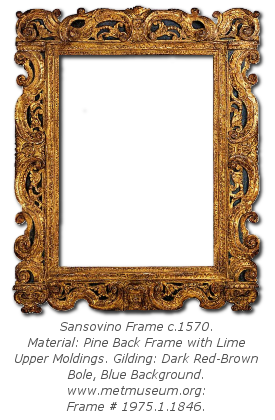
The distinctive characteristics of the frame are a "profusion of overlapping and intertwining scrolls and volutes, often rusticated, sometimes pierced and free-standing, sometimes contained within the squared silhouette of a colored black frame, occasionally enlivened with birds, rows of pearls, festoons, cartouches, clasps, cherub heads, or escarpa." [2] This framing technique, named after the artist Jacopo Sansovino (1486-1570), was perfected in the 16th century.
Auricular Frame:
In Northern Europe, namely Netherlands and England, the Auricular frame developed during the 17th century. Unlike the Sansovino frame and its architectural form, Auricular frames were more fluid and ornamentation shifted to mostly organic themes.
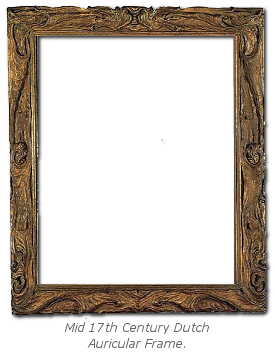
Some identifiable features are a straight sight-edge and that the frames appear to have a melting quality: "metamorphosing shapes mimic swirling lines of molten silver and gold in contemporary metalwork. Frames in this manner also attempt to reproduce the fluidity of metal in carved wood ... The leathery, weave-like, scrolling effect produced in the wood ... is the organic equivalent of the architectural 'Sansovino' frame, and seems almost to have been formed from a Tuscan Mannerist frame which had been left too near the fire and begun to melt." [3]
Auricular "Sunderland" Frame:
The Sunderland frame is a manifestation of the Auricular frame that was in fashion c.1660-c.1680, during the reign of Charles I. Features that help to identify a Sunderland frame are a top rail cartouche, bottom rail grotesque mask and either a straight sight-edge or a "serrated ... sight edge that breaks into the painted area." [4] Auricular Sunderland frames are almost always finished in a pale, blond gold.
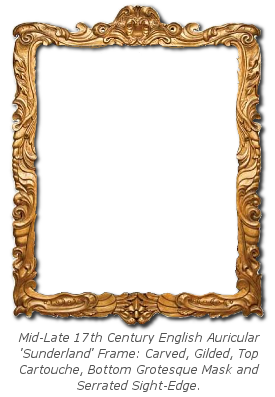
Auricular frames got their name because they often include "cartilaginous" forms and shapes that resemble the human ear and ear lobes; Hence the name 'auricular' - which means, "relating to the ear or hearing ... shaped like an auricle".
Auricular "Medici" Frame:
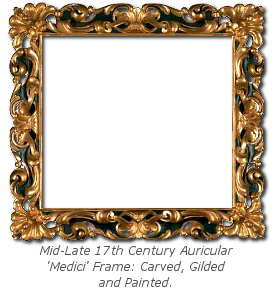
The Italian version of the Auricular frame, known as the Medici frame, appeared during the 17th century, having the straight sight-edge of the Auricular frame, and is otherwise "much more sculpted and three-dimensional." [3] Ornamentation is frequently marine themed, incorporating some of the Sansovino features like the clasp, volute and black and gold coloring.
Spanish Herrera Frame:
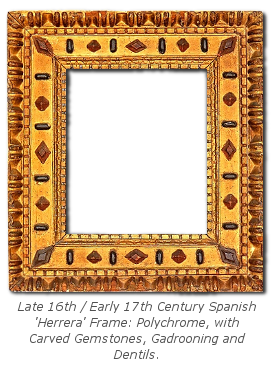
The Spanish Herrera frame took on a more geometrical, architectural form that utilized, "chunky, block-like shapes: Gadrooning, dentils, zigzag dogtooth, hooked clasps and cotton-reel mouldings and raised gem-like ornaments in the form of round and oval cabochons or squares and lozenges peaked like pyramidal jewels." [3] Center and corner decorations may also be present.
References:
- www.wikipedia.com, "Mannerism", (Retrieved 03/19/13)
- www.metmuseum.org, "Heilbrunn Timeline of Art History: Italian Renaissance Frames - The Gallery Frame", (Retrieved 08/09/12)
- Paul Mitchell and Lynn Roberts, "Frameworks: Form, Function & Ornament in European Portrait Frames", ISBN: 1-85894-037-0
- www.npg.or.uk (National Portrait Gallery), "Framing in the reign of Charles II and the introduction of the Sunderland frame", (Retrieved 03/20/13)
Bibliography:
- www.wikipedia.com, "Mannerism", (Retrieved 03/19/13)
- www.metmuseum.org, "Heilbrunn Timeline of Art History: Italian Renaissance Frames - The Gallery Frame", (Retrieved 08/09/12)
- Paul Mitchell and Lynn Roberts, "Frameworks: Form, Function & Ornament in European Portrait Frames", ISBN: 1-85894-037-0
- www.npg.or.uk (National Portrait Gallery), "Framing in the reign of Charles II and the introduction of the Sunderland frame", (Retrieved 03/20/13)
- D. Gene Karraker, "Looking at European Frames: A guide to terms, styles and techniques", ISBN-10: 0892369817, ISBN-13: 978-089236981